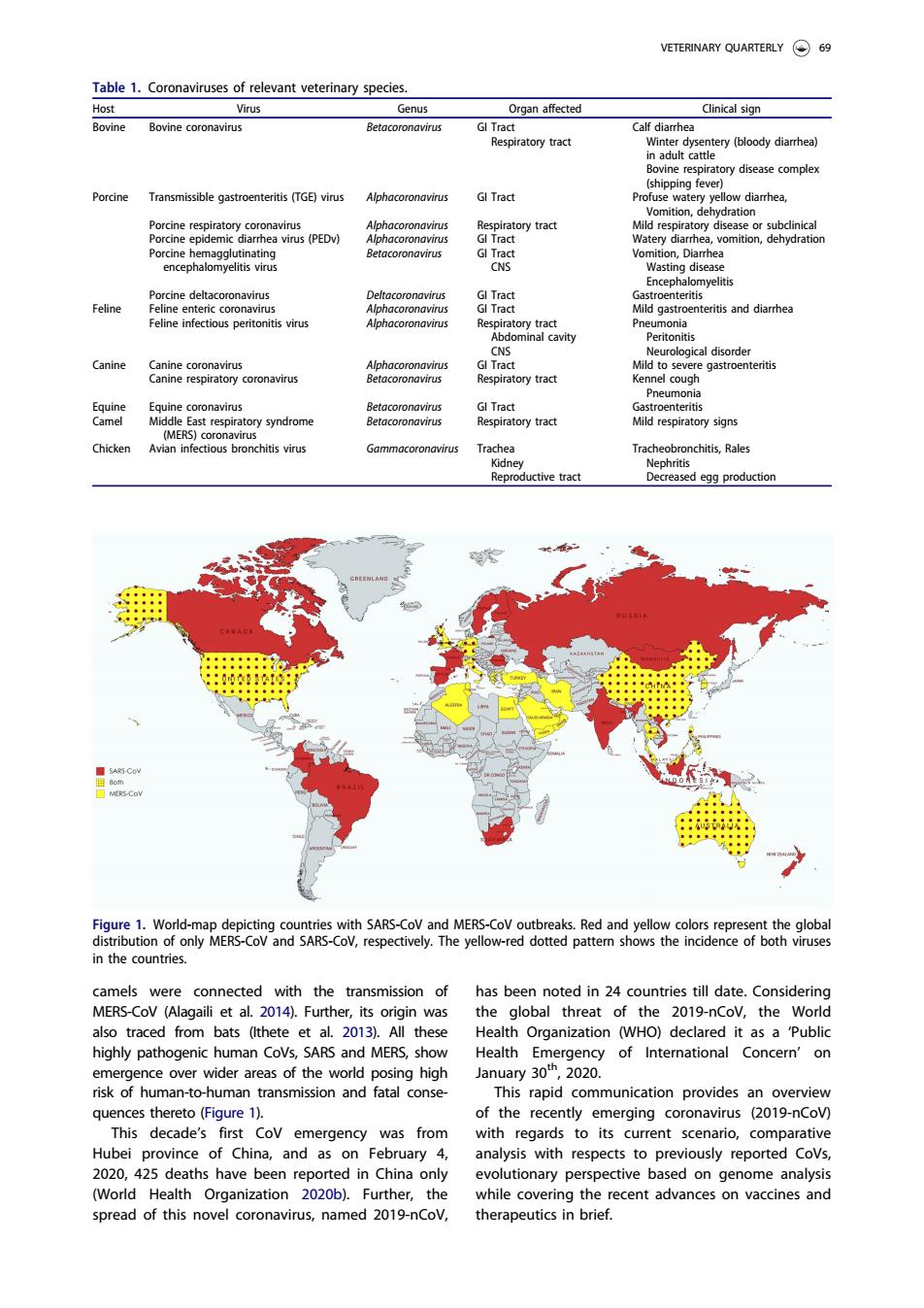正在加载图片...

VETERINARY QUARTERLY④6的 Table1.Coronaviruses of relevant veterinary spece Host Genus Organ affectec Clinical sign tory tra ory disease c pp Porcine diarrhea nica is and diarrhea Canine anheceorpar5oonsis ory tract Chicken Decreased egg productio camels were connected with the transmission of has been noted in 24 countries till date.Considering MERS-CoV (Alagaili et al.2014).Further,its origin was the global threat of the 2019-nCoV,the World also traced from bats (lthete et al.2013).All these Health Organization (WHO)declared it as a Public highly pathogenic nan Cov RS and MERS,show Health Emergency of International Concern'on -to areas or the uary s anid es thereto (Figure 1). of the recently emerging coronavirus (2019-nCov This decade's first Cov emergency was from with regards to its current scenario,comparative Hubei province of China,and as on February 4, analysis with respects to previously reported CoVs nave bee b) China only nary pe e d of ad 2018-ncov rief camels were connected with the transmission of MERS-CoV (Alagaili et al. 2014). Further, its origin was also traced from bats (Ithete et al. 2013). All these highly pathogenic human CoVs, SARS and MERS, show emergence over wider areas of the world posing high risk of human-to-human transmission and fatal consequences thereto (Figure 1). This decade’s first CoV emergency was from Hubei province of China, and as on February 4, 2020, 425 deaths have been reported in China only (World Health Organization 2020b). Further, the spread of this novel coronavirus, named 2019-nCoV, has been noted in 24 countries till date. Considering the global threat of the 2019-nCoV, the World Health Organization (WHO) declared it as a ‘Public Health Emergency of International Concern’ on January 30th, 2020. This rapid communication provides an overview of the recently emerging coronavirus (2019-nCoV) with regards to its current scenario, comparative analysis with respects to previously reported CoVs, evolutionary perspective based on genome analysis while covering the recent advances on vaccines and therapeutics in brief. Table 1. Coronaviruses of relevant veterinary species. Host Virus Genus Organ affected Clinical sign Bovine Bovine coronavirus Betacoronavirus GI Tract Respiratory tract Calf diarrhea Winter dysentery (bloody diarrhea) in adult cattle Bovine respiratory disease complex (shipping fever) Porcine Transmissible gastroenteritis (TGE) virus Alphacoronavirus GI Tract Profuse watery yellow diarrhea, Vomition, dehydration Porcine respiratory coronavirus Alphacoronavirus Respiratory tract Mild respiratory disease or subclinical Porcine epidemic diarrhea virus (PEDv) Alphacoronavirus GI Tract Watery diarrhea, vomition, dehydration Porcine hemagglutinating encephalomyelitis virus Betacoronavirus GI Tract CNS Vomition, Diarrhea Wasting disease Encephalomyelitis Porcine deltacoronavirus Deltacoronavirus GI Tract Gastroenteritis Feline Feline enteric coronavirus Alphacoronavirus GI Tract Mild gastroenteritis and diarrhea Feline infectious peritonitis virus Alphacoronavirus Respiratory tract Abdominal cavity CNS Pneumonia Peritonitis Neurological disorder Canine Canine coronavirus Alphacoronavirus GI Tract Mild to severe gastroenteritis Canine respiratory coronavirus Betacoronavirus Respiratory tract Kennel cough Pneumonia Equine Equine coronavirus Betacoronavirus GI Tract Gastroenteritis Camel Middle East respiratory syndrome (MERS) coronavirus Betacoronavirus Respiratory tract Mild respiratory signs Chicken Avian infectious bronchitis virus Gammacoronavirus Trachea Kidney Reproductive tract Tracheobronchitis, Rales Nephritis Decreased egg production Figure 1. World-map depicting countries with SARS-CoV and MERS-CoV outbreaks. Red and yellow colors represent the global distribution of only MERS-CoV and SARS-CoV, respectively. The yellow-red dotted pattern shows the incidence of both viruses in the countries. VETERINARY QUARTERLY 69